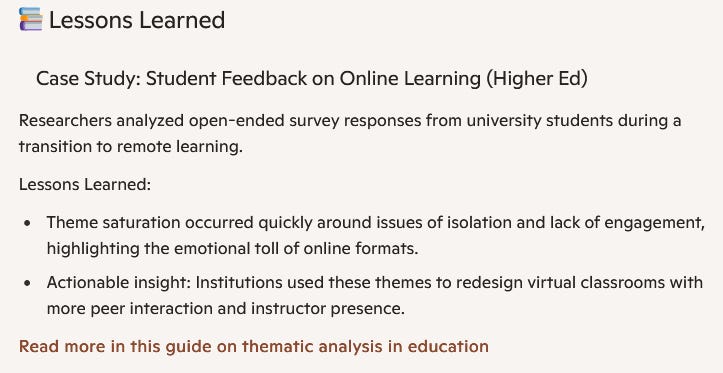Thematic analysis is a tool for understanding open-ended qualitative data. How should I approach what I think I know or my thesis, to whatever else there is to discover across the qualitative data?
Insights from Thematic Analysis of Open-Ended Data
Patterns Reveal Deeper Meaning: Thematic analysis helps uncover recurring ideas, emotions, or concerns that may not be immediately obvious. These patterns often reflect shared experiences or systemic issues that quantitative data might miss.
Flexibility Enables Rich Interpretation: Whether an inductive (data-driven) or deductive (theory-driven) approach, thematic analysis adapts to your research goals. This makes it ideal for exploratory studies or refining hypotheses.
Coding is Iterative and Interpretive: The process of coding, labeling chunks of text with meaningful tags is more than mechanical. It requires reflection, refinement, and sometimes re-coding as themes evolve and become clearer.
Lessons Learned from Case Studies
Case Study: Student Feedback on Online Learning (Higher Ed)
Researchers analyzed open-ended survey responses from university students during a transition to remote learning.
Lessons Learned:
Theme saturation occurred quickly around issues of isolation and lack of engagement, highlighting the emotional toll of online formats.
Actionable insight: Institutions used these themes to redesign virtual classrooms with more peer interaction and instructor presence.
[Read more in this guide on thematic analysis in education]
Case Study: Healthcare Workers’ Experiences COVID-19
A qualitative study used thematic analysis on interviews with frontline workers.
Lessons Learned:
Unexpected themes emerged around moral injury and identity conflict, which weren’t part of the initial research focus.
Practical outcome: These insights informed mental health interventions tailored to healthcare professionals’ lived experiences.
[Explore the thematic analysis process in health research]
There are several themes that I enjoy...
Customer product feedback loops: likes, wish lists & complaints (for example, nuances in reviews that list comparisons, data collection, and competing products. Reddit, YT and blog comment aggregation insights)
Employee Experiences - for example any type of summaries from Glassdoor, Indeed, or industry publications
Patient Perspectives on Healthcare Services (though I'm intrigued with placebo effect trials, experiments, and journal studies)
LMS & EdTech platforms for knowledge management and training (interest in instructional design)
Example posts (I'm intrigued by the potential for theme summaries & synthesis of resources to understand the why and how of user values across marketplaces)
Author’s note: I prefer Microsoft Copilot & Perplexity, though let's see how SearchGPT unfolds. Prompt experimentation from most of the books I reviewed are already outdated. For content development there are AgentGPTs that are already prompt engineered, though I'm following several organizations that share case studies about how they plug in AirOps, Dorik, Databar, etc. -Marky
Examples of thematic analysis applied to open-ended qualitative data:
Example 1: Customer Feedback on a New Product
Themes identified:
Product Satisfaction: Includes positive or negative experiences with the product’s performance.
Ease of Use: Refers to the user-friendliness and intuitive design.
Customer Support: Concerns about the effectiveness and availability of customer service.
Value for Money: Perceived cost-effectiveness of the product.
Example 2: Employee Experiences in a Remote Work Environment
Themes identified:
Work-Life Balance: Challenges and benefits related to balancing work and personal life.
Communication: Effectiveness of virtual communication tools and practices.
Productivity: Factors influencing employee productivity while working remotely.
Isolation: Feelings of loneliness or disconnectedness from the team.
Example 3: Patient Perspectives on Healthcare Services
Themes identified:
Quality of Care: Patients' perceptions of the medical treatment received.
Accessibility: Ease of accessing healthcare services and facilities.
Communication: Clarity and empathy in interactions with healthcare providers.
Wait Times: Experiences related to the duration of waiting for appointments or treatment.
Example 4: Student Feedback on Online Learning
Themes identified:
Engagement: Levels of student participation and interest in online classes.
Technical Issues: Problems faced with the technology used for online learning.
Instructor Support: Availability and effectiveness of instructors in an online setting.
Learning Outcomes: Students' perceptions of their academic progress and achievements.
Regarding student success operations, I’ve already had noted an approach and strategy, which you’ll notice some overlap with the themes.
Each theme helps researchers understand common patterns and issues within the data, providing insights for improvement and decision-making.
While one cannot expect AI platform tools to do the thinking for them, such platform aides can help folks that do not have access to research & analytic teams and departments for guidance and collaboration. -Marky


